

The morning was nice and clear. We had breakfast by the campfire. We left for our drive and quickly came upon a giraffe getting a morning snack. We saw an old elephant, which Malinga noted was old because old elephants get wrinkles on their ears. He also explained that elephants have feeling on their trunks much like we have on our fingers, allowing them to feel around for fruits and berries. We also saw some "darker" impala – apparently their hair poofs out when it is cold outside, and that makes them look darker.
 |
 |
We drove up to the northern edge of the island, not far from Vumbura, in search of rhino. While we found no rhino, we found a ton of other animals in nice open plains. It reminded us of the San Diego Wild Animal Park in terms of appearance and density, but with no fences and the chance that the animals could get eaten at any point. If anything, there were more animals than at the Wild Animal Park, especially lechwe. There were also zebras, a giant kudu up on a termite mound, and several pink-backed pelicans. We saw a carmine bee eater, which stood still while we tried and tried to get a picture that was in focus. It must have taken 30 photos, at various vantage points, until we got some good ones. All told, the bird stayed still for about 5 minutes, waiting patiently. We kept going, and we saw tons of wildebeest and zebra and antelope. We also saw two more honey badgers.
 |
 |
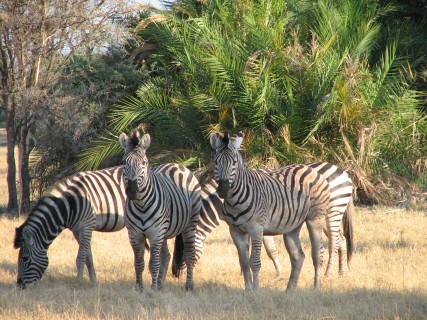 |
 |
 |
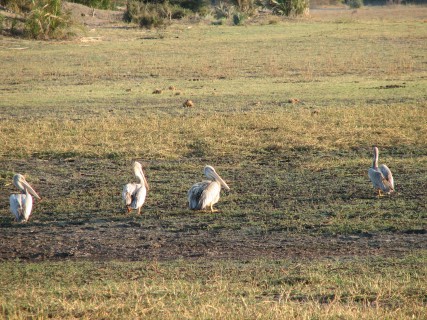 |
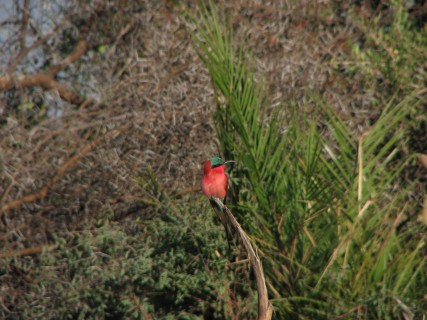 |
 |
 |
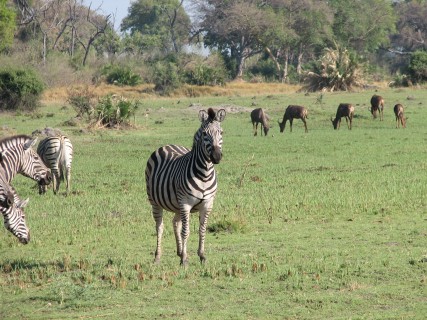 |
 |
While looking for a rhino – which we didn't actually find – Malinga told us about rhinos. Malinga explained to us how when the rhinos were first re-introduced into the area, many of the other animals were petrified of them because they had never seen a rhino before. Rhinos are one of the only, if not the only, animal re-introduced into Botswana . The reason for this was because rhinos were killed off by hunting instead of natural reasons. Currently there are 35 white rhinos and 4 black rhinos in Botswana , all of which were re-introduced around Mombo and have taken off from there. Malinga also told us a bit about spring hares, specifically how they are very odd animals. They have tracks like a predator and stomachs like a herbivore, not to mention they jump around like a kangaroo.
Moving on, away from the green areas, we saw 19 lionesses and sub-adults, all full from something they got this morning. One was blind in one eye, which is how the guides distinguish the two groups – we saw the Moporota. Some of the better shots included:
 |
 |
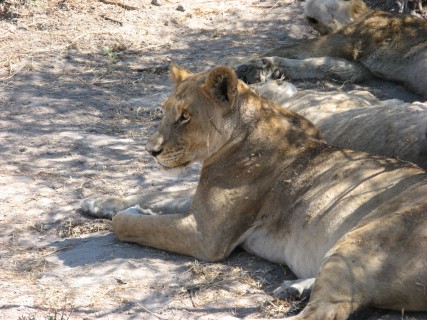 |
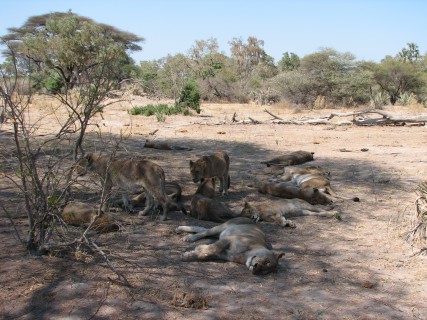 |
 |
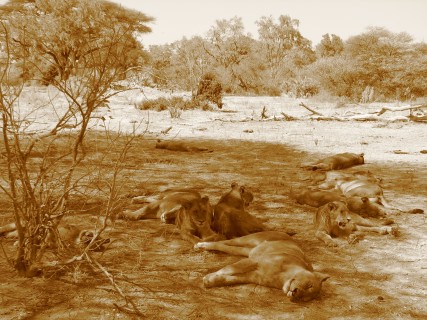 |
 |
 |
 |
As we were leaving, Malinga told us that one of the other guides had spotted a leopard across the island, and were we willing to drive over there, as we would be late to eat. It took half a second for us to say drive. On the way we went past another nice green plains area, which we asked to go back to in the afternoon. We also saw another massive baobab tree as well as a group of elephants that passed right in front of our truck.
 |
 |
The leopard was way up in a sausage tree – apparently it had been treed by some baboons earlier in the morning. We had to keep driving around to get a good vantage point, but did finally get to some good spots where she was visible in the sun – she looked either full or pregnant. Some of the better pictures we got were:
 |
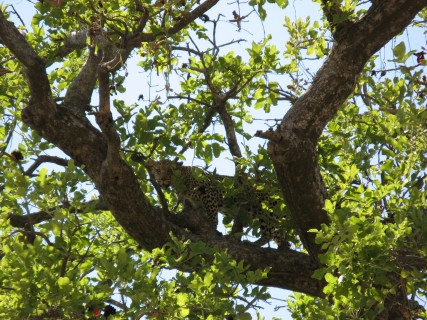 |
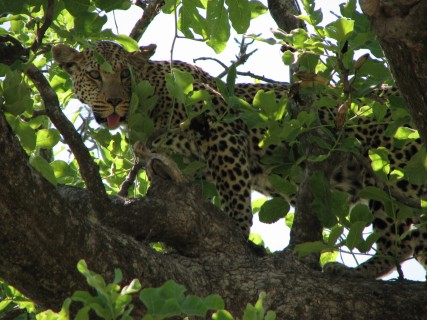 |
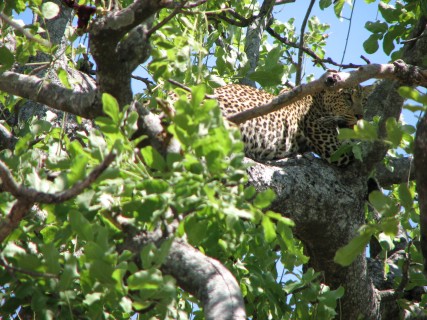 |
 |
 |
We drove back and had lunch, where we enjoyed good food and the entertainment of vervet monkeys trying to steal items out of the kitchen. It was akin to a military mission, with some monkeys acting as decoys to distract the staff while others snuck in and grabbed the food. A mom and baby waited patiently for the others to grab snacks. Apparently the mom did not want to put her baby at risk.
 |
 |
On our afternoon drive, Crystal asked how much water an elephant could hold in its trunk, and Malinga told us it could hop 10 liters of water at any given time. Shortly after leaving camp, we found an elephant lying down, which at first we thought was sick, since they should not be lying down that late. We quickly realized she was fine, but in discomfort, and then we saw what very visibly were contractions (check out the video below at the 20 second mark) – she was in labor! Unfortunately, labor can take 24-36 hours, so we continued to drive around, hoping we would catch up with her later.
We drove down south, to the Zimbira area (near where we were picked up from Xigera), and looked at more of the floodplains. It actually resembled a golf course, with large open areas surrounded by clumps of trees – not to mention sand traps. There was still no rhino, but we saw a ton of other animals, including 50+ giraffes. They were not in large groups, but rather solo or in small groups. One of them was eating well up on a tree. We also saw tons of zebra, wildebeest, and different types of antelope - including a big group running from something. There were a couple of juvenile male impala fighting.
 |
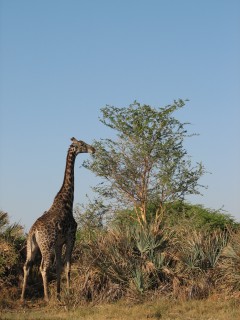 |
 |
 |
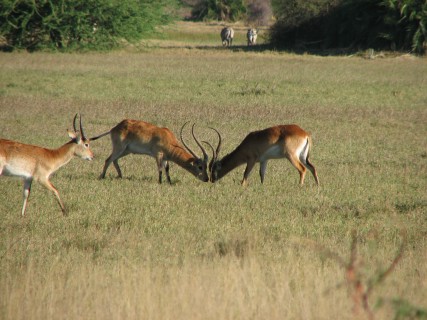 |
We got some good photos of a carmine bee eater, which patiently sat for us, and then flew away and spread it wings for the camera. We went down near the water, going past the massive Zimbira baobab. At the water, we saw a rather large croc on the shore. We were watching the croc, a hippo lounging around in the water, and a fish eagle up in the tree, for about 5-10 minutes. When we started to leave, we realized there was a male lion not 10 feet from where we had been stopped the whole time, just around the corner of a palm grove. After that, we saw another elephant imitating Cinco, stretching to get at tree branches. We started heading back, and stopped for a nice sundowner and got a group photo. The sunset over the palm trees reminded us of home.
 |
 |
 |
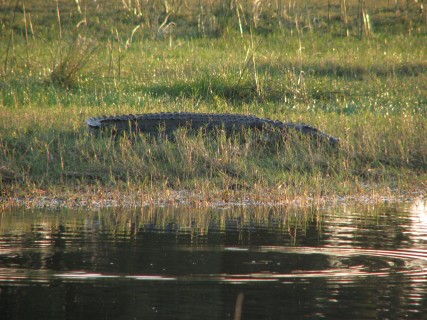 |
 |
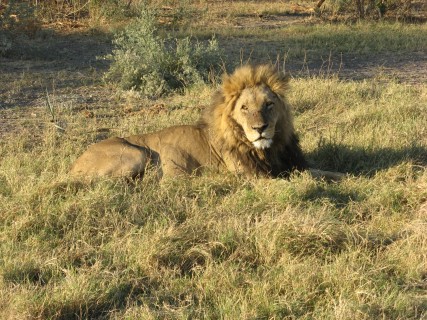 |
 |
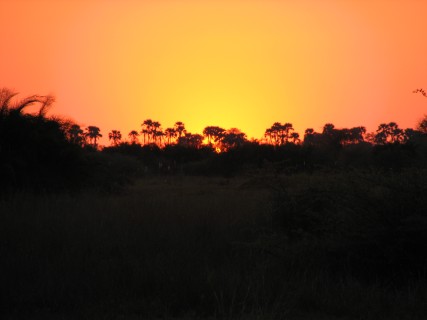 |
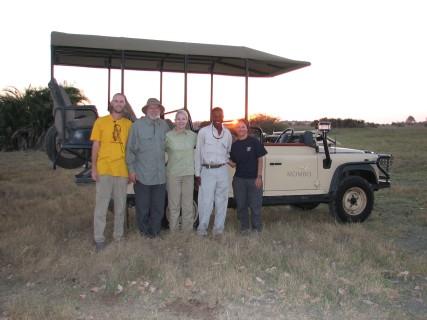 |
 |
At dinner, we were at the "communal" table, separated from the San Diego people, so that was nice. We ended up speaking with George and Kaye, who had sold their place and were traveling the world. They were very nice and gave us a couple places for our "to do" list, which we reciprocated – too bad we did not meet more people like them on our trip. We reflected, and came to the conclusion that Selinda seemed to have the most down-to-earth couples.
We went back to the tent and prepared for our last day in Botswana.